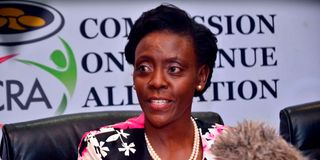Release Sh42bn Equalisation Fund, state told

Outgoing Commission for Revenue Allocation (CRA) Chairperson Dr Jane Kiringai. The CRA now wants President William Ruto’s administration to release the funds, which will “breathe new life into the bottom-up approach by reaching the 5.6 million Kenyans.
The government is on the spot over its failure to disburse Sh42 billion Equalisation Fund money to marginalised areas over the past six years.
The funds are expected to assist 5.6 million people in 1,400 sub-locations. Counties have also been faulted for low own-source revenue collection of Sh35 billion against a capacity to generate in excess of Sh200 billion.
The Commission on Revenue Allocation (CRA) now wants President William Ruto’s administration to release the funds, which will “breathe new life into the bottom-up approach by reaching the 5.6 million Kenyans,” according to outgoing CRA chair Dr Jane Kiringai.
She spoke at State House in Nairobi on Tuesday during a meeting of commissions and independent offices.
Dr Kiringai revealed that, between financial years 2013-14 and 2022-23, Parliament allocated Sh57.7 billion through various Division of Revenue Acts.
The 14 counties that have suffered decades of marginalisation are Turkana, Lamu, Mandera, Wajir, Marsabit, Samburu, West Pokot, Tana River, Narok, Kwale, Garissa, Kilifi, Taita Taveta and Isiolo. However, only Sh12.4 billion has been released to the counties.
Dr Kiringai told the Senate last year that the balance of Sh42.88 billion is yet to be appropriated to the beneficiary areas.
Article 204 of the Constitution on Equalisation Fund establishes “… an Equalisation Fund into which shall be paid one half per cent of all the revenue collected by the national government each year calculated on the basis of the most recent audited accounts of revenue received, as approved by the National Assembly.”
Basic services
The law empowers the government to use the fund only to provide basic services including water, roads, health facilities and electricity to marginalised areas to the extent necessary to bring the quality of services in those areas to the level generally enjoyed by the rest of the nation.
The article lapses twenty years after the effective date, subject to the subsidiary law enacted by Parliament.
“Parliament may enact legislation suspending the effect of the 12-year period for a further fixed period of years, subject legislation supported by more than half of all the members of the National Assembly, and more than half of all the county delegations in the Senate.”
In December last year, governors faulted MPs on the proposed laws guiding the distribution of funds to the counties. The Council of Governors (CoG) took issue with the Equalisation Fund Bill, 2022, terming it unconstitutional.
“The Council of Governors objects to the Bill in its entirety for reasons that it is fundamentally flawed as it fails to conform to the High Court judgment, the devolved structure of governance and the Equalisation Fund Regulations, 2021,” CoG vice chair and Wajir Governor Ahmed Abdullahi had said at the time.
The Bill, currently before the Senate, allocates only Sh13.48 billion, leaving a balance of Sh29.4 billion that is due to the counties.
The re-introduced Bill was first brought before the 12th Parliament. The proposed law, if enacted, will compel Treasury to release all the outstanding funds to implement the projects earmarked for development in marginalised counties.
At the same time, CRA has expressed concern with the own-source revenues generated by county governments at a time when they have received Sh3 trillion in equitable share since the onset of devolution in 2013.
Dr Kiringai recalled Dr Ruto’s sentiments when he chaired the Inter-Governmental Budget and Economic Council (IBEC) as Deputy President when he noted that own-source revenue in counties is a “sleeping giant”.
“ I believe counties can do more. They are now raising Sh35 billion annually in own-source revenue yet studies have shown that they can generate an average of in excess of Sh200 billion. It can be done,” said Dr Kiringai.
She noted that, since 2013 when the equitable share was Sh190 billion, it has increased to Sh407 billion in this financial year which totals Sh3trillion.
Farewell event
She said: “If we can come up with a good competitive grant and create incentives for counties, the potential is significant. We should develop a unified system for revenue collection, which should be automated.”
Dr Kiringai, who has one month left at the commission, was among the two chairs whose terms have come to an end and had a farewell event organised by the President.
Others are the Independent Electoral and Boundaries Commission (IEBC) chairman Wafula Chebukati and his Ethics and Anti-Corruption Commission (EACC) counterparts, whose terms ended on January 17.
Dr Kiringai’s parting shot also touched on the financing of the country’s cities, which she said contributes 60 per cent of the Gross Domestic Product and water scarcity.
“If well functioning, counties have the capability to expand the middle class. Counties should get more funding. Proper funding is the basis for economic transformation and is part of the Kenya Kwanza administration structure,” said Dr Kiringai.





